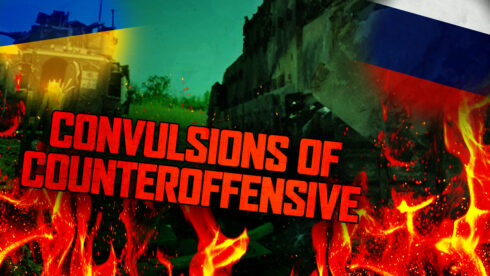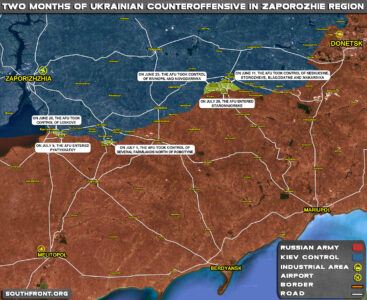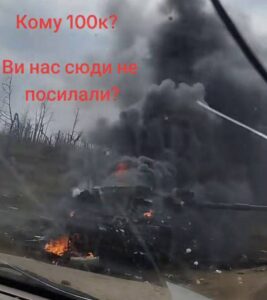Written by Pietro Pinter, a Doctor in International Relations, author of italian-language geopolitics blog inimicizie.com
Over the past 100 days, a contingent of about 12 brigades, equipped with the best military supplies NATO was able to offer – and with what remained of the strategic reserve of Soviet armoured vehicles – which had been in preparation since at least last winter, has been hurling itself against equally long-prepared Russian defensive lines.
According to most authoritative analyses – one of them being that of US Chief of Staff Mark Milley – the Ukrainian offensive will be exhausted in the next 30-60 days due to the changing weather – which will make the predominantly rural terrain of the Zhaporozhye a muddy swamp – and the deterioration of offensive capabilities due to attrition.
The UAF, despite some tactical successes, are extremely far from ‘gaining strategically important objectives that will ensure greater weight at the negotiating table’, as the US National Security Advisor – Jake Sullivan – predicted in early June. LINK
In the main theatre of operations, the assault reached a maximum depth of 10 kilometres and, as Milley’s above-mentioned interview – from 11 September – clearly showed, did not penetrate the first of the 3 main Russian defence lines, contrary to what some sources claim.
The Ukrainian contingent concentrated its efforts in the depressions – always characterised by lower terrain than the surrounding areas – that proved most vulnerable in the first days of ‘reconnaissance in force’: this occurred just east of the Dnipro near the village of Pyatikhatky, in the central sector – where the fiercest fighting has been concentrated in recent days – in Rabotino, 10km from the Ukrainian starting lines, and in the ‘Vremensky ledge’. The assault, however, failed to break through the main defence lines and the heights controlled by the Russian armed forces, to reach strategic targets such as Tokmak, a town located 20km from the current Ukrainian positions, a key motorway and railway junction of the land corridor between southern Russia and Crimea, a bastion of the third (and last) defensive line. LINK
Should this state of affairs be confirmed at the end of the offensive, the balance for Kiev could only be negative. Ukraine would have expended an assault force that is almost impossible to replicate in the short to medium term to achieve limited tactical success, without any strategic success. A situation similar to that of ‘Operation Charlie’, the last German assault of the First World War, which – although it succeeded in penetrating the Anglo-French lines – failed to change the course of the war before the arrival in force of the US contingent and the exhaustion of German resources.
The comparison is deliberately exaggerated: NATO supplies to the Ukraine will not run out overnight, and the capacity of the Russian war industry – although considerably increased in the last year – will probably not be able to allow a massive offensive capable of radically changing the course of the war, but the problem, for Kiev, remains. F- 16s, ATACMS long-range missiles, and perhaps – something the Ukrainian foreign minister takes for granted, almost ritually humiliating his German counterpart Barbock – also the Taurus missiles. LINK But – on this almost everyone agrees – the dream of a blitzkrieg towards the Black Sea that would take Russia by surprise and lead it to a brief capitulation is fading. On the horizon is confirmed the prospect – indeed already quite clear from the stabilisation of the Russian lines after the painful retreats from Kherson and Kharkov – of a long war of attrition.
A form of warfare that does not play in Ukraine’s favour, due to that ‘asymmetry of will’ that has characterised almost all NATO expeditionary wars (and this is undoubtedly an American-led NATO war) since World War II. At issue is not the Ukrainian willingness to fight – which has shown no signs of relenting – but rather the coalition’s willingness (and in some cases, the very possibility) to support its war effort at current levels. One can read in the prestigious – and influential – Foreign Affairs that ‘The main risk to Ukraine is not so much an abrupt political change in the West, but the slow unravelling of a carefully woven network of foreign assistance‘. It is a pretty sound judgment. Constant but reduced support – the UK has already declared, for example, that it will not replace the Challenger tank, one out of 14 sent, destroyed in battle – may be able to allow Ukraine to survive the war, but not win it. And this could lead to a change of strategy: a Western Europe preoccupied with the economic crisis and the need to secure its trade links in Eurasia, and an America absorbed by the more important conflict with China, or the less important but closer crisis on its southern border, might want to end the all-out war in Ukraine and – assuming an understanding can be found, which is not a foregone conclusion given Moscow’s now total bet on the ‘special military operation’ – come to terms with its Russian enemies.
Zelensky is well aware of this and has declared that he is prepared for a ‘perennial’ war ‘without a happy ending’. To deal with it, the Ukrainian leader is trying to cleanse the country of the image of corruption that is raising more and more criticism – especially in the USA – concerning the destination of funds sent to the country, impeaching oligarchs, commissioners and even sacking the defence minister, who has been accused of embezzlement for months. On the other hand, in the absence of a real war industry – except for excellence in the field of aerial and naval drones – mobilising the main resource Ukraine can bring to the war: its own population. The wholesale dismissal of all military commissars in the country, the removal of conscription exemptions for students and certain categories of sick people, and the pressure on European countries to extradite refugees eligible for military service prelude an even more extensive mobilisation than the previous ones, perhaps on the model of the total mobilisation experienced in some districts of the country.
Less clear are the next steps of Russia, which has not attempted any significant offensive effort since taking Bakhmut, except for minor operations in the direction of Kupyansk during the Ukrainian offensive. For the time being, the Kremlin excludes new mobilisations, invests in the expansion of the war industry, reinforces the defence of its critical infrastructures, tries to repair strategic agreements that have entered a crisis (Turkey, Armenia), develop those that have worked (India, China, Saudi Arabia, Iran) and forge new ones, however improbable (North Korea, Myanmar). It solves – with spectacular violence and by retiring generals of suspicious loyalty – its internal power struggles.
In all likelihood, the Kremlin, too, is preparing for a long-term war, which it will have to manage as a structural factor in its foreign and military policy, and no longer as a whirlwind emergency. What it has in common with Ukraine is that its performance on the ground – and in the eventual diplomacy of the conflict – will be limited not so much by its willingness to fight, but by its ability to do so with its own means, depending on those that NATO can and will put in place.









100 days of shame to the pigs of the kiev nazi junta
no happy ending? sound about on par for life in the west.
just a reminder, for those who aren’t aware. russia has been stockpiling diesel in vast amounts. ththey have a significant stockpile set aside now in addition to their currently used stock. this is indicating that they believe they will require vast amounts of fuel for their machines in the coming weeks and months. an offensive looks to be in the near future.
pro ukr prop, not analysis! rus is way more capable than ukr, with/without nato’s junkyard munitions. regardless of where c&c centres are, active personnel and hardware are in ukraine, and so easily wiped out by superior rus. z is a busted flush, and any ‘total mobilisation’ of grannies and kids is self inflicted genocide. once rus takes the handbrake off, it’s over for kiev’s nazi puppets; and usa knows this.
yes so now biden plans to send atacm weapons to zelensky for the explicit purpose of continuing this war even closer to thermal nuclear extinction. biden and his handlers are now seen as satanic for this
defense officials admit the us does not have a large stockpile of excess atacms, and there is still debate about the ‘type’ of missile and number to be sent.
z is a played out pow(d)er junkie, biden is nearing the end of any credibility, and the us $$ printing presses are creaking at minus $33trn. the usa has all but given up on z and co, but hesitant rus must still apply the ‘coup de grace’ to the illegal kiev puppet junta.
reading between the lines, and using poland as a gauge, the usa has given up on this biden business venture. therefore supplying atacms has one reason only, to provoke rus into flattening ukraine (and so letting nato off the hook).
but why must rus wait for rus cities to be hit by atacms, with hundreds killed, when this whole mess could be over in weeks with a determined, full-force, unapologetic push into ukraine? why dance to dixie’s tune?
“zelensky is well aware of this and has declared that he is prepared for a ‘perennial’ war ‘without a happy ending’.”
the installed degenerate zelenesky is prepared to double his daily cocain intake.